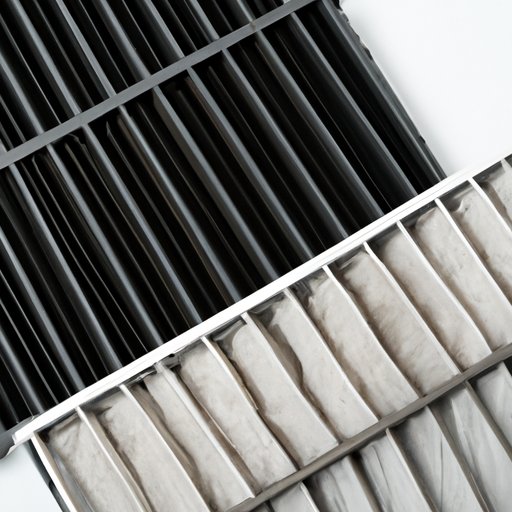I. Introduction
When it comes to indoor air quality, installing air filters correctly can make a significant difference. However, many homeowners don’t give much thought to how air filters are installed, assuming that all filters are the same. In reality, installing air filters the wrong way can lead to various issues, from poor air quality to HVAC system malfunctions. In this article, we’ll explore which way air filters go and why it’s essential to install them correctly.
II. The Importance of Installing Air Filters the Right Way
Properly installing air filters is vital for maintaining good indoor air quality. Filters are designed to trap airborne particles, such as dust, pollen, and pet dander, preventing them from circulating throughout your home. However, if these filters are installed incorrectly, they won’t be as effective, and your air quality will suffer.
Additionally, installing air filters incorrectly can lead to problems with your HVAC system. When filters are not installed properly, they can restrict airflow, which puts added strain on your system. Over time, this can lead to higher energy bills, more frequent repairs, and even premature system failure.
III. Common Mistakes When Installing Air Filters and How to Avoid Them
One common mistake when installing air filters is forgetting to remove the old filter before replacing it with a new one. When two filters are installed on top of one another, airflow is restricted, and your HVAC system must work harder to circulate air properly.
Another mistake is installing the filter backwards or upside down. Ensuring that the air flow arrow is pointed in the right direction is crucial for filter efficiency.
To avoid these mistakes, always thoroughly read the manufacturer’s instructions before installing a new filter. Make sure to turn off your HVAC system and remove the old filter before installing a new one. Verify that the airflow arrow is in the correct direction and that the filter is secure in the filter slot.
IV. 5 Signs You’re Installing Air Filters Incorrectly
1. High energy bills: If you notice a sudden increase in your energy bills, your air filters may be installed incorrectly and restricting airflow.
2. Poor air quality: If you notice more dust or particles in the air, it may be a sign that your filters are not working correctly.
3. Strange smells: If you notice a lingering musty or stale odor in your home, this may be a result of air filters that are clogged or installed the wrong way.
4. Uneven temperature distribution: If you notice certain rooms are consistently warmer or cooler than others, this may be due to restricted airflow caused by incorrectly installed filters.
5. Unusual sounds: If your HVAC system makes strange noises, such as rattling or clanging, it may be due to restricted airflow caused by air filters installed the wrong way.
V. Step-by-Step Guide: How to Properly Install Your Air Filters
Before starting, gather your supplies: a new air filter, a screwdriver (if necessary), and the HVAC manufacturer’s instructions.
1. Turn off your HVAC system.
2. Locate the air filter slot. This is usually near the return air duct.
3. Remove the old filter by gently pulling it out of the filter slot.
4. Check the filter slot for any debris or buildup and clean if necessary.
5. Verify the correct airflow direction of the filter by locating the airflow arrow printed on the side of the filter.
6. Insert the new filter into the filter slot, making sure that the airflow arrow is pointing in the correct direction.
7. Make sure the filter is securely in place.
8. Turn your HVAC system back on.
VI. Uncovering the Truth: Do Air Filters Really Have a ‘Right Way’ to be Installed?
There is a debate surrounding whether air filters have a right way to be installed. While it may seem like a small detail, the importance of airflow direction cannot be overstated. Proper airflow direction is necessary to ensure that the filter is efficient in collecting airborne particles. Overall, it is best to follow the manufacturer’s instructions, as each system can be unique in its requirements.
VII. Why DIY Homeowners Should Care About Air Filter Directions
Diy homeowners should pay attention to air filter directions to ensure that they are maintaining their HVAC system properly. Filters that are installed incorrectly may lead to more significant problems down the road, such as costly repairs. Being mindful of the way filters are installed will also help homeowners to monitor their air quality and take steps to maintain optimal indoor conditions.
VIII. Don’t Let This Small Mistake Cost You: How Incorrectly Installed Air Filters Affect Your Home’s Air Quality
When air filters are installed incorrectly, they are unable to properly filter out airborne debris and pollutants. As a result, air quality in the home can suffer. This can lead to complications such as respiratory issues, allergies, and asthma. Additionally, poor air quality can exacerbate existing conditions, decrease productivity, and cause uncomfortable conditions within the home.
It’s essential to maintain good air quality by regularly replacing air filters and doing so correctly. Additionally, taking steps like using air purifiers or opening windows can help to improve indoor air quality.
IX. Conclusion
While it may seem like a small and insignificant detail, properly installing air filters can make a significant impact on your HVAC system and indoor air quality. Avoiding common mistakes and following manufacturer’s instructions will help ensure that your filters are installed correctly. Remember, regular maintenance and replacement of air filters is essential to maintain optimal air quality in your home.
Be sure to take the necessary steps, including replacing your air filters, properly installing them, and using additional measures to maintain optimal air quality in your home.
